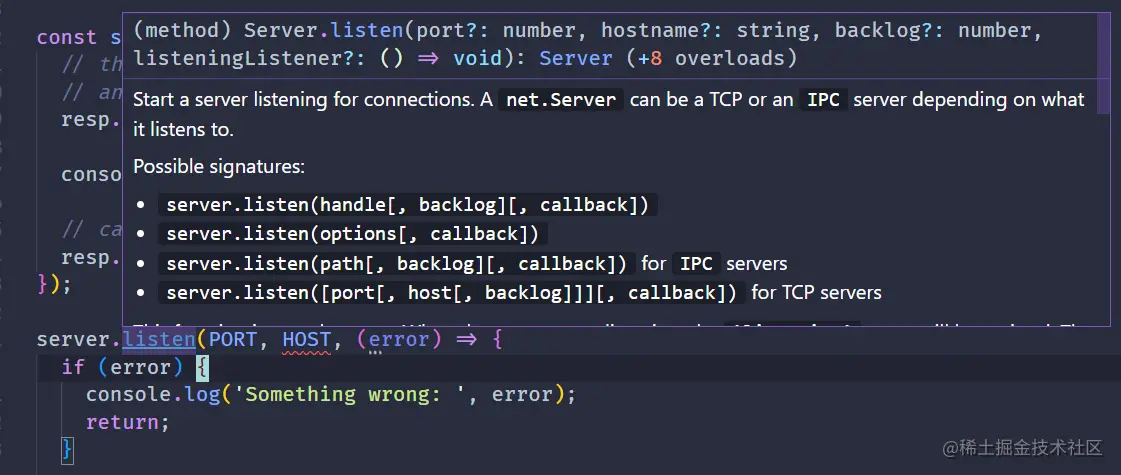Node.js を使用して単純な HTTP サーバーを作成する方法について説明します。
NodeJS を使用して HTTP サーバーを作成するにはどうすればよいですか?次の記事では、Node を使用して簡単な HTTP サーバーを作成する方法を紹介します。

1. Node.js を使用して JavaScript スクリプトを直接実行する
node.js Chrome に基づく v8 エンジンは js コードを実行するため、ブラウザ環境を削除して js コードを実行できますコンソールで直接実行します。たとえば、次の hello worldcode
console.log('hello world'); は、コンソールで node を使用して直接実行できます

2. 単純な HTTP サーバー
node.js の組み込みモジュール http を作成します。 CommonJS 仕様に基づいて、基本的な httpService 機能を提供します。require を使用して、http モジュールをインポートして使用できます。 httpモジュールには ## があります。#createServer 関数を使用すると、http サーバーを作成できます。
コールバック関数をパラメータとして受け取ります。このコールバック関数は、request と response
- request
- の 2 つのパラメータを受け取り、すべての情報が含まれます
url、リクエストヘッダーheader、リクエストメソッドとリクエストボディなど、クライアントによってリクエストされたもの。 response - は主に次の目的で使用されます。クライアントは、応答本文に関連するいくつかの操作をカプセル化します。たとえば、
response.writeHeadメソッドを使用すると、戻り本文のヘッダー情報とステータス コードをカスタマイズできます#応答本文を処理した後、response.end()
createServer 関数を使用すると、Server オブジェクトが作成されるだけで、リッスンできるようにはなりません。また、server の listen## を呼び出す必要もあります。 オブジェクト。#このメソッドはリッスンに使用でき、実際にサーバーとして実行を開始できます。#listen
- ip
- 、3 番目のパラメータはコールバック関数で、
httpモジュールによって非同期的に呼び出されます。エラーが発生した場合は、は、このコールバック関数の最初のパラメータで呼び出すことができます。スローされた例外を取得した後、サーバーをより堅牢にするために例外を処理することを選択できます。次は、## の使用例です。 #http単純なサーバーを作成するモジュール
const { createServer } = require('http');
const HOST = 'localhost';
const PORT = '8080';
const server = createServer((req, resp) => {
// the first param is status code it returns
// and the second param is response header info
resp.writeHead(200, { 'Content-Type': 'text/plain' });
console.log('server is working...');
// call end method to tell server that the request has been fulfilled
resp.end('hello nodejs http server');
});
server.listen(PORT, HOST, (error) => {
if (error) {
console.log('Something wrong: ', error);
return;
}
console.log(`server is listening on http://${HOST}:${PORT} ...`);
});node を使用して直接実行して、自分に属するサーバーを作成してみることができます。サーバーが実行されたら、ブラウザは http://localhost:8080
コードを変更したときにプログラムを手動で終了して再実行する必要がないように実行します。 
npm i -g nodemon
npx nodemon# 経由 ##使用するには
使い方も非常に簡単で、node コマンドを
コマンド <div class="code" style="position:relative; padding:0px; margin:0px;"><pre class="brush:php;toolbar:false">nodemon http-server.js</pre><div class="contentsignin">ログイン後にコピー</div></div># コマンドに変更するだけです。 #3 .タイププロンプトを追加
 以前に
以前に
および
resp オブジェクトを使用したときは、構文プロンプトが表示されなかったため、 # に従う必要があります。 # at any time. #node 使用中に公式ドキュメントを確認するのは少し不便です。 しかし、問題はありません。
ts の .d.ts ファイルを使用して、構文プロンプトを提供できます。ts を使用していないことに注意してください。開発の場合は、それを使用するだけです。 構文プロンプト関数は、 プロジェクトを初期化するだけです -- npm init -yInstall@types/node
- pnpm i @types/node -D
-
プロジェクト ディレクトリにjsconfig.json - ファイルを作成し、
node_modulesを除外します。チェックする必要はありません{ "compilerOptions": { "checkJs": true }, "exclude": ["node_modules", "**/node_modules/*"] }ログイン後にコピー 上記のコードに実際にエラーがあることがわかったでしょうか? - checkJs
は型エラーのチェックに役立ちます。必要に応じて有効にするかどうかを選択できます。 ご覧のとおり、チェックをオンにすると、すぐにパラメーター タイプの不一致の問題が表示されます。
listen# の上にマウスを置きます。 ## メソッド、メソッドの署名が確認できます<p><img src="/static/imghw/default1.png" data-src="https://img.php.cn/upload/image/807/794/868/1656306106827160.png" class="lazy" title="1656306106827160.png" alt="Node.js を使用して単純な HTTP サーバーを作成する方法について説明します。"></p>
<p>可以看到,原来<code>port参数需要是number类型,但是我们定义的时候是string类型,所以没匹配上,将其修改为number的8080即可
而且可以直接查看到相关api的文档,不需要打开node官方的文档找半天去查看了
4. 返回多个字符串的响应体
前面我们的简单http server中只返回了一句话,那么是否能够返回多句话呢?
这就要用到resp对象的write方法了,end只能够返回一次内容,而是用write方法,我们可以多次写入内容到响应体中,最后只用调用一次end,并且不传递任何参数,只让他完成发送响应体的功能
const { createServer } = require("http");
const HOST = "localhost";
const PORT = 8080;
const server = createServer((req, resp) => {
resp.writeHead(200, { "Content-Type": "text/plain" });
console.log("server is working...");
// write some lorem sentences
resp.write("Lorem ipsum dolor sit amet consectetur adipisicing elit.\n");
resp.write("Omnis eligendi aperiam delectus?\n");
resp.write("Aut, quam quo!\n");
resp.end();
});
server.listen(PORT, HOST, (error) => {
if (error) {
console.log("Something wrong: ", error);
return;
}
console.log(`server is listening on http://${HOST}:${PORT} ...`);
});这次我们写入了三句话,现在的效果就变成这样啦

5. 返回html
我们不仅可以返回字符串给浏览器,还可以直接读取html文件的内容并将其作为结果返回给浏览器
这就需要用到另一个Node.js的内置模块 -- fs,该模块提供了文件操作的功能
使用fs.readFile可以异步进行读取文件的操作,但是它不会返回promise对象,因此我们需要传入回调去处理读取到文件后的操作
还可以使用fs.readFileSync进行同步阻塞读取文件,这里我们选择异步读取
const { createServer } = require("http");
const fs = require("fs");
const HOST = "localhost";
const PORT = 8080;const server = createServer((req, resp) => {
// change the MIME type from text/plain to text/html
resp.writeHead(200, { "Content-Type": "text/html" });
// read the html file content
fs.readFile("index.html", (err, data) => {
if (err) {
console.error(
"an error occurred while reading the html file content: ",
err
); throw err;
}
console.log("operation success!");
resp.write(data);
resp.end();
});
});
server.listen(PORT, HOST, (error) => {
if (error) {
console.log("Something wrong: ", error);
return;
}
console.log(`server is listening on http://${HOST}:${PORT} ...`);
});现在的结果就像下面这样:

成功将html返回注意:这里需要将响应头的**Content-Type**改为**text/html**,告知浏览器我们返回的是**html**文件的内容,如果仍然以**text/plain**返回的话,浏览器不会对返回的内容进行解析,即便它是符合**html**语法的也不会解析,就像下面这样:
6. 返回JSON
当我们需要编写一个后端服务器,只负责返回接口数据的时候,就需要返回json格式的内容了,相信聪明的你也知道该怎么处理了:
- 将
MIME类型设置为application/json -
resp.write的时候传入的是json字符串,可以使用JSON.stringify处理对象后返回
const { createServer } = require("http");
const HOST = "localhost";
const PORT = 8080;
const server = createServer((req, resp) => {
// change the MIME type to application/json
resp.writeHead(200, { "Content-Type": "application/json" });
// create a json data by using an object
const jsonDataObj = {
code: 0,
message: "success",
data: {
name: "plasticine",
age: 20,
hobby: "coding",
},
};
resp.write(JSON.stringify(jsonDataObj));
resp.end();
});
server.listen(PORT, HOST, (error) => {
if (error) {
console.log("Something wrong: ", error);
return;
}
console.log(`server is listening on http://${HOST}:${PORT} ...`);
});结果如下:
7. 返回pdf文件
和之前返回html文件的思路类似,都是一个设置响应头MIME类型,读取文件,返回文件内容的过程
但是这次我们搞点不一样的
我们的思路是在服务器运行的时候生成一个pdf文件,并将它返回
还需要将MIME的类型改为application/pdf生成pdf文件需要用到一个库 -- pdfkit
pnpm i pdfkit
首先我们编写一个创建pdf文件的函数,因为创建pdf文件还需要进行一些写入操作,不确定什么时候会完成,但是我们的请求必须等到pdf文件创建完成后才能得到响应
所以我们需要将它变成异步进行的,返回一个promise
/**
* @description 创建 pdf 文件
*/const createPdf = () => {
return new Promise((resolve, reject) => {
if (!fs.existsSync("example.pdf")) {
// create a PDFDocument object
const doc = new PDFDocument();
// create write stream by piping the pdf content.
doc.pipe(fs.createWriteStream("example.pdf"));
// add some contents to pdf document
doc.fontSize(16).text("Hello PDF", 100, 100);
// complete the operation of generating PDF file.
doc.end();
}
resolve("success");
});
};这里使用到了管道操作,将PDFDocument对象的内容通过管道传到新创建的写入流中,当完成操作后我们就通过resovle告知外界已经创建好pdf文件了
然后在服务端代码中调用
const server = createServer(async (req, resp) => {
// change the MIME type to application/pdf
resp.writeHead(200, { "Content-Type": "application/pdf" });
// create pdf file
await createPdf();
// read created pdf file
fs.readFile("example.pdf", (err, data) => {
if (err) {
console.error(
"an error occurred while reading the pdf file content: ",
err
);
throw err;
}
console.log("operation success!");
resp.end(data);
});
});
server.listen(PORT, HOST, (error) => {
if (error) {
console.log("Something wrong: ", error);
return;
}
console.log(`server is listening on http://${HOST}:${PORT} ...`);
});现在浏览器就可以读取到创建的pdf文件了
8. 返回音频文件
思路依然是一样的,读取一个音频文件,然后通过管道将它送到resp对象中再返回即可
const { createServer } = require("http");
const { stat, createReadStream } = require("fs");
const HOST = "localhost";
const PORT = 8080;
const server = createServer((req, resp) => {
// change the MIME type to audio/mpe
resp.writeHead(200, { "Content-Type": "audio/mp3" });
const mp3FileName = "audio.mp3";
stat(mp3FileName, (err, stats) => {
if (stats.isFile()) {
const rs = createReadStream(mp3FileName);
// pipe the read stream to resp
rs.pipe(resp);
} else {
resp.end("mp3 file not exists");
}
});
});
server.listen(PORT, HOST, (error) => {
if (error) {
console.log("Something wrong: ", error);
return;
}
console.log(`server is listening on http://${HOST}:${PORT} ...`);
});效果如下
打开后就是一个播放音频的界面,这是chrome提供的对音频文件的展示,并且打开控制台会发现有返回音频文件
注意:将音频文件流通过管道传到**resp**后,不需要调用**resp.end()**方法,因为这会关闭整个响应,导致音频文件无法获取
9. 返回视频文件
视频文件和音频文件的处理是一样的,只是MIME的类型要改成video/mp4,其他都一样
const { createServer } = require("http");
const { stat, createReadStream } = require("fs");
const HOST = "localhost";
const PORT = 8080;
const server = createServer((req, resp) => {
// change the MIME type to audio/mpe
resp.writeHead(200, { "Content-Type": "audio/mp4" });
const mp4FileName = "video.mp4";
stat(mp4FileName, (err, stats) => {
if (stats.isFile()) {
const rs = createReadStream(mp4FileName);
// pipe the read stream to resp
rs.pipe(resp);
} else {
resp.end("mp4 file not exists");
}
});
});
server.listen(PORT, HOST, (error) => {
if (error) {
console.log("Something wrong: ", error);
return;
}
console.log(`server is listening on http://${HOST}:${PORT} ...`);
});总结
我们学会了:
- 如何使用
Node创建一个http服务器 - 给
js加上类型提示 - 如何返回字符串响应体
- 如何返回
html - 如何返回
JSON - 如何生成并返回
pdf文件 - 如何返回音频文件
- 如何返回视频文件
虽然内容简单,但还是希望你能跟着动手敲一敲,不要以为简单就看看就算了,看了不代表会了,真正动手实现过后才会找到自己的问题
更多node相关知识,请访问:nodejs 教程!
以上がNode.js を使用して単純な HTTP サーバーを作成する方法について説明します。の詳細内容です。詳細については、PHP 中国語 Web サイトの他の関連記事を参照してください。

ホットAIツール

Undresser.AI Undress
リアルなヌード写真を作成する AI 搭載アプリ

AI Clothes Remover
写真から衣服を削除するオンライン AI ツール。

Undress AI Tool
脱衣画像を無料で

Clothoff.io
AI衣類リムーバー

AI Hentai Generator
AIヘンタイを無料で生成します。

人気の記事

ホットツール

メモ帳++7.3.1
使いやすく無料のコードエディター

SublimeText3 中国語版
中国語版、とても使いやすい

ゼンドスタジオ 13.0.1
強力な PHP 統合開発環境

ドリームウィーバー CS6
ビジュアル Web 開発ツール

SublimeText3 Mac版
神レベルのコード編集ソフト(SublimeText3)

ホットトピック
 7540
7540
 15
15
 1381
1381
 52
52
 83
83
 11
11
 21
21
 86
86
 Nodejs はバックエンド フレームワークですか?
Apr 21, 2024 am 05:09 AM
Nodejs はバックエンド フレームワークですか?
Apr 21, 2024 am 05:09 AM
Node.js は、高いパフォーマンス、スケーラビリティ、クロスプラットフォーム サポート、豊富なエコシステム、開発の容易さなどの機能を備えているため、バックエンド フレームワークとして使用できます。
 Nodejsをmysqlデータベースに接続する方法
Apr 21, 2024 am 06:13 AM
Nodejsをmysqlデータベースに接続する方法
Apr 21, 2024 am 06:13 AM
MySQL データベースに接続するには、次の手順に従う必要があります。 mysql2 ドライバーをインストールします。 mysql2.createConnection() を使用して、ホスト アドレス、ポート、ユーザー名、パスワード、データベース名を含む接続オブジェクトを作成します。 connection.query() を使用してクエリを実行します。最後に connection.end() を使用して接続を終了します。
 Nodejs インストール ディレクトリ内の npm ファイルと npm.cmd ファイルの違いは何ですか?
Apr 21, 2024 am 05:18 AM
Nodejs インストール ディレクトリ内の npm ファイルと npm.cmd ファイルの違いは何ですか?
Apr 21, 2024 am 05:18 AM
Node.js インストール ディレクトリには、npm と npm.cmd という 2 つの npm 関連ファイルがあります。違いは次のとおりです。拡張子が異なります。npm は実行可能ファイルで、npm.cmd はコマンド ウィンドウのショートカットです。 Windows ユーザー: npm.cmd はコマンド プロンプトから使用できますが、npm はコマンド ラインからのみ実行できます。互換性: npm.cmd は Windows システムに固有ですが、npm はクロスプラットフォームで使用できます。使用上の推奨事項: Windows ユーザーは npm.cmd を使用し、他のオペレーティング システムは npm を使用します。
 Nodejsのグローバル変数とは何ですか
Apr 21, 2024 am 04:54 AM
Nodejsのグローバル変数とは何ですか
Apr 21, 2024 am 04:54 AM
Node.js には次のグローバル変数が存在します。 グローバル オブジェクト: グローバル コア モジュール: プロセス、コンソール、require ランタイム環境変数: __dirname、__filename、__line、__column 定数: unknown、null、NaN、Infinity、-Infinity
 NodejsとJavaの間に大きな違いはありますか?
Apr 21, 2024 am 06:12 AM
NodejsとJavaの間に大きな違いはありますか?
Apr 21, 2024 am 06:12 AM
Node.js と Java の主な違いは、設計と機能です。 イベント駆動型とスレッド駆動型: Node.js はイベント駆動型で、Java はスレッド駆動型です。シングルスレッドとマルチスレッド: Node.js はシングルスレッドのイベント ループを使用し、Java はマルチスレッド アーキテクチャを使用します。ランタイム環境: Node.js は V8 JavaScript エンジン上で実行され、Java は JVM 上で実行されます。構文: Node.js は JavaScript 構文を使用し、Java は Java 構文を使用します。目的: Node.js は I/O 集中型のタスクに適しており、Java は大規模なエンタープライズ アプリケーションに適しています。
 PIノードティーチング:PIノードとは何ですか? PIノードをインストールしてセットアップする方法は?
Mar 05, 2025 pm 05:57 PM
PIノードティーチング:PIノードとは何ですか? PIノードをインストールしてセットアップする方法は?
Mar 05, 2025 pm 05:57 PM
ピン張りのノードの詳細な説明とインストールガイドこの記事では、ピネットワークのエコシステムを詳細に紹介します - PIノードは、ピン系生態系における重要な役割であり、設置と構成の完全な手順を提供します。 Pinetworkブロックチェーンテストネットワークの発売後、PIノードは多くの先駆者の重要な部分になり、テストに積極的に参加し、今後のメインネットワークリリースの準備をしています。まだピン張りのものがわからない場合は、ピコインとは何かを参照してください。リストの価格はいくらですか? PIの使用、マイニング、セキュリティ分析。パインワークとは何ですか?ピン競技プロジェクトは2019年に開始され、独占的な暗号通貨PIコインを所有しています。このプロジェクトは、誰もが参加できるものを作成することを目指しています
 Nodejs はバックエンド開発言語ですか?
Apr 21, 2024 am 05:09 AM
Nodejs はバックエンド開発言語ですか?
Apr 21, 2024 am 05:09 AM
はい、Node.js はバックエンド開発言語です。これは、サーバー側のビジネス ロジックの処理、データベース接続の管理、API の提供などのバックエンド開発に使用されます。
 Nodejsプロジェクトをサーバーにデプロイする方法
Apr 21, 2024 am 04:40 AM
Nodejsプロジェクトをサーバーにデプロイする方法
Apr 21, 2024 am 04:40 AM
Node.js プロジェクトのサーバー デプロイメント手順: デプロイメント環境を準備します。サーバー アクセスの取得、Node.js のインストール、Git リポジトリのセットアップ。アプリケーションをビルドする: npm run build を使用して、デプロイ可能なコードと依存関係を生成します。コードをサーバーにアップロードします: Git またはファイル転送プロトコル経由。依存関係をインストールする: サーバーに SSH で接続し、npm install を使用してアプリケーションの依存関係をインストールします。アプリケーションを開始します。node Index.js などのコマンドを使用してアプリケーションを開始するか、pm2 などのプロセス マネージャーを使用します。リバース プロキシの構成 (オプション): Nginx や Apache などのリバース プロキシを使用して、トラフィックをアプリケーションにルーティングします。












